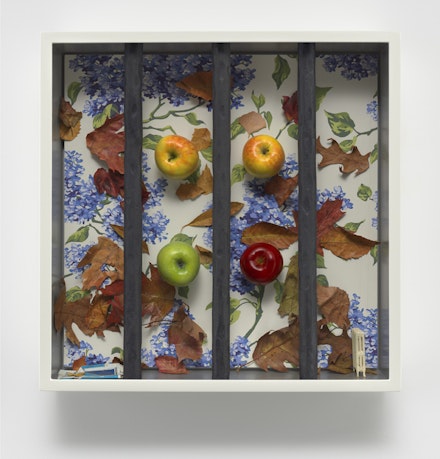ArtSeen
ROBERT GOBER:
Tick Tock
Robert Gober, Untitled, 2000-2001. Wood, paint, concrete, cast plastic, human hair, overall approximately: 80 x 48 x 72 inches. © Robert Gober, Courtesy Matthew Marks Gallery.
On View
Matthew MarksFebruary 23 – April 21, 2018
New York
Some artists don’t like to explain their art; Robert Gober is one of them. For much of his career, he has avoided interviews. The ones he has given are tart. “You know, this interview is going to be a problem, because I’m not innately drawn to coming up with sentences about my work,” he told a journalist in 1989. Asked by another, on the occasion of a large exhibition at the Schaulager in Basel, if he wanted to explain what he was trying to say, Gober replied: “No, not really.”
Most of his works are untitled; so are most of his shows. But since his revelatory 2014 – 2015 Museum of Modern Art (MoMA) retrospective, he has eased his proscription against offering clues. “I don’t know how else you would understand it without metaphor,” he said of his work in the Brooklyn Rail on the occasion of the MoMA show. “It is one essential way to experience and feel something about the pieces.” As if to press the point inversely, he titled the retrospective The Heart is not a Metaphor.
The framing device Gober offers for his quiet new exhibition at Matthew Marks, his first since the MoMA show, is time, which is a recognition of the long gestation period of many of these thirty-nine objects. (The show is titled Tick Tock.) Nineteen of these works were made over the course of at least four years. One of them—an untitled relief sculpture locked into a two-by-two foot box by forged iron bars, behind which are four naturalistic apples fashioned from beeswax and copper that’s been cut, shaped, and painted to look like a cigarette box, all set against a floral wallpaper background—is dated 1978–2018. Other relief boxes, such as Road with Butter, which has a false stick of butter (also made of beeswax) set against wallpaper depicting a hilly, paved road surrounded by grass and trees, have similarly extended dates. It was made between 1979 and 2018.
The dating is not conceptual. It isn’t that Gober conceived of these works years ago and only executed them recently. Instead, each new sculpture includes materials or remnants of objects the artist made years ago. In Road with Butter, the background with the road motif is printed from a linoleum block he made in 1979. In the untitled apple box, there is a miniature apartment radiator carved from balsa wood that Gober originally made for a doll house in 1978.
The show also includes sixteen drawings, most of them on vellum, fourteen of which include one of his long-favored motifs, the prison window. A majority of these new pictures depict the barred window, behind which there is the blue sky of freedom, in the center of a man’s or a woman’s back or chest. Across these torsos, Gober has drawn trees, some of which are just stumps. Strictly speaking, these are the newest objects in the exhibition; all of them are dated 2017. The exhibition also presents, for the first time in America, an installation he made for the 2001 Venice Biennale: an open cellar, leading down a short flight of stairs, to a yellow wooden door, beyond which glows some strange light. The installation is not a reinvention; the painted wood and concrete are the ones he used in Venice.
Gober has always returned to former motifs in new works (sinks, limbs, cribs, and chairs), but never before with time in mind. In the past, old forms cropped up again and again for the opposite reason: because Gober was continually trying to create or capture some unchanging ideal, which cannot be marred or improved. Asked once about his interest in drains, which appear repeatedly in his work, he said he initially wanted only to make a mold of the drain in his kitchen sink. It didn’t work. “I looked for a comparable store-bought drain,” he said, “but they weren't making them anymore, so I bought three different drains, cut them up, and welded the pieces back together to create what I saw as a quintessential drain.”
This is what we are used to expecting from Gober’s work, some “quintessential” version of things we already know. That Platonic tendency is largely absent in the new exhibition, and Gober, instead, is inventing anew by combining common forms in unforeseen ways. That’s what’s happening in the relief boxes and drawings of prison windows on torsos, which offer a smaller frame of reference than before. Unlike his sink or furniture sculptures, the new works refer primarily to his past motifs instead of something outside themselves. The result is a somewhat muted show, one that’s less obviously ambitious than some of his previous efforts. But it is refreshing to see a new path open in a considered way, rather than with bloated extravagance.



